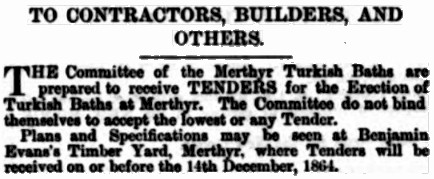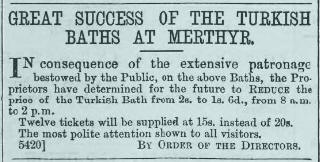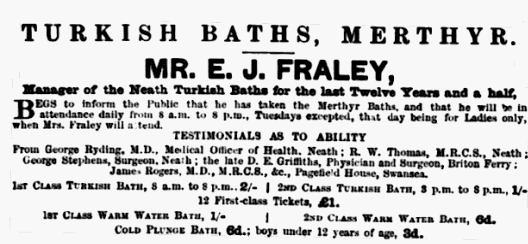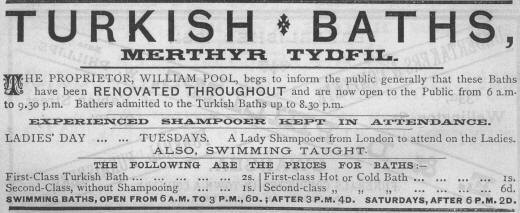Early years
A Turkish bath for Merthyr seems to have first been mooted some time early in 1864. Its unknown promoters had applied to the local water board for special terms for the supply of water to their proposed bathhouse, and this had been approved.
However this project went no further and, early in September, a new committee was formed to make a another attempt at providing baths for the town. It appears that the original request for cheaper water had been granted on the grounds that so few inhabitants had access to clean water that the promoters' work had a 'patriotic character' in providing not only Turkish baths, but also hot and cold slipper baths, thereby making 'ample provision for the requirements of the "great unwashed".'
The spokesman for the new committee, the Rev O Evans, submitted a similar request for lower rates, assuring the board that they were no less patriotic, and that they were less motivated by 'a prospect of high dividends, but rather by a desire to supply a want felt in the town, especially by invalids'. He said that though there was no present intention to provide a swimming pool, they had space enough available if sufficiently urged by the public to do so.
But at that stage, Evans was merely given the printed scale of charges for non-domestic use of water, and was told that the committee would 'be treated with all the liberality that they could, consistently with their duty to the general ratepayers, show to them.'
With this, the committee had to be satisfied, and at the beginning of December they advertised for tenders for the erection of Turkish baths in the town.

The baths were designed by a Mr Benjamin Evans, constructed by a local builder, Phillip Davis of Castle Street, and opened to the public on Thursday 12 April 1866.
There is some doubt as to the status of the bath proprietors at this time. Until the opening, they had been referred to as 'The Committee of the Merthyr Turkish Baths', but the Merthyr Express, in its article on the opening, stated that the baths had been built 'by a Limited Liability Company, the shareholders in which are all residents of Merthyr and Dowlais'.

Yet although this advertisement—published a couple of months after the opening—was signed, 'By Order of the Directors', The National Archives (TNA) has no record of any Merthyr baths company which was in existence at this time.
Normally, records relating to limited liability companies which have been discontinued would be included in TNA's Class BT31. There are a number of possible reasons for their absence. They might, for example, have been destroyed by Companies House in one of their weeding operations prior to their records being transferred to TNA, or the Express might simply have got it wrong and it had been a private company.
As for the content of the advertisement, it is difficult to tell whether the decision to make a couple of price reductions really was because the baths were so successful, or if it was quickly realised that the original price was too high for most of the town's population.
The same suspicion also arises after reading an earlier paragraph in the Cardiff and Merthyr Guardian which wonders, after learning that 'the patronage has been great and continuous' in the 'present fickle days of Spring', what they will 'have to chronicle in the dog days!'
The baths building, reported to have cost around £900, was divided into two, one part having been designed to provide accommodation for a resident manager and his wife.
The baths themselves comprised a large cooling-room slightly warmer than the air outdoors at 80 degrees Fahrenheit. Along one side was a series of numbered changing cubicles, each with white curtains, trimmed with Ottoman red and decorated with a crescent. Along the opposite wall stood a row of loungers (adjustable couches) for relaxation after the bath. In exchange for an admission ticket, each bather was provided with a gown and a small towelling loincloth.
There were two hot rooms, maintained at 140 and 180 degrees, each heated by hot air in the open area, supplemented by hot water pipes below the seats. A shampooing room with douches, where the bather removed his loincloth and was cleansed and massaged, led through a large opening into a plunge pool, described as 'a sort of acquatic [sic] gymnasium.'
Once the baths were actually open, the directors were extremely well supported by members of the water board who agreed to supply water free of charge until their income exceeded 5% of their investment outlay.
The first manager was a Mr Wiseman who had previously been with Bartholomew's Baths in Bristol, but there is no mention of a Mrs Wiseman, seen as essential if provision was to be made for women bathers. This may be the reason why, quite soon after opening, the baths were being managed by (the married) Mr Thomas Atkins.
In October 1867 there seems to have been a concerted push to publicise the baths. Three pieces describing the bath and the bathing procedure were published in the Merthyr Express. In form, they appeared to be letters to the editor. Two were from a writer signing himself 'Anselmo', and the third was from 'A New Disciple of the Bath'. Whether these were genuine letters from independent bathers, or paid-for puffs, it certainly looked as though someone at the Express had an interest in the success of the baths.
For these were not just straightforward descriptions of the baths, with undoubtedly well-deserved praise for Mr Atkins, but they proactively encouraged the public to use them. And Anselmo's second letter seems also to have had a partially hidden agenda.
For my own part, having tested the beneficial character of the bath, I think it a great pity that the company do not make them more widely known. But there, Mr Editor, I have no faith in public companies, for such things, they mean very well, but it is everyone's business and nobody's and, consequently, the thing is not done. They ought to let the place to somebody—I know nobody so fit as Mr Atkins—for a moderate but fair percentage on the capital expended—say 4 per cent.—or 5 per cent. for four years, until they see how the thing pays. I don't think the Turkish Baths will ever be properly known and patronised in Merthyr except somebody takes to them who will noise their fame abroad—for a fame they have which, for the sake of humanity, in this district ought not to be under a bushel.
The actual ownership of the baths now becomes obscure again. During the years between 1868 and 1871, local directories (which are notoriously inaccurate on matters of ownership and management) variously refer to Atkins as superintendant, manager, or (by implication) proprietor.
Usually, when considering Turkish baths and swimming pools, the designation superintendent or manager refers to the person in day to day charge of the establishment, employed for this purpose by the proprietors, whether these be local authorities, businesses, or private individuals.
But where such establishments are not run by local authorities, the meaning of the term proprietor is often unclear. It might refer to the owner of both the baths business and the building itself, but more frequently it refers only to the proprietor of the business who leases the building from its owner. Lessee is often used for the latter, but the indeterminate designation proprietor is far more frequently used.
In the case of the Merthyr Turkish Baths, Atkins was employed as manager. He was referred to in that capacity in the three letters published by the Express; but in Slater's Directory for Merthyr Tydfil he is referred to as superintendent.
While the following year, the Express reports that at a meeting of the water board, the Chairman asked whether the baths should not now pay for their water since 'he heard that the Turkish Baths were now a private speculation'.
So it looks as though Anselmo's proposal in his second letter to the Express had been put into practice, and this seems to be confirmed by Kelly's 1871 Directory of Monmouthshire (which would have actually been published in 1870) where Atkins is entered as proprietor. However, Atkins must surely have leased the baths from the committee which set them up, for it is extremely unlikely that he would have been able, at that time, to afford the sum required to purchase the building.
To complicate matters even further, on 3 March 1871 a new company, the Merthyr Turkish Bath Company Limited was set up 'to erect and provide Turkish Baths'. Shortly afterwards they purchased the baths almost certainly from the original committee, though the possibility that the company purchased them from Atkins, who may have been able to buy them at a knockdown price, cannot be completely ruled out.
The baths company years
The company's stated object to erect a Turkish bath was probably inserted in case there might be a later possibility of future expansion. It must have been clear that the town would not be able to support a second establishment. In any event a company with only a partly subscribed capital set at 1,200 £10 shares could not have afforded to build one. So, for whatever reason, the directors decided that an easier way forward would be to purchase the existing baths and get Atkins to remain on as manager.
It is clear, from the early letter to the Express, that Atkins was an effective and well liked manager, and the baths seemed to run smoothly for several years. Even so, baths in such a small town could not have been making all that much profit—probably under 5%, since the baths were still obtaining water free of charge in 1873.
Mrs Atkins must also have been fully involved in running the baths. By 1878, there were first and second class baths, according to the time of day, and the Turkish baths were reserved for women on Tuesday and Friday. Additionally, private first and second class hot water baths were available for men and women every day, though all the baths were, of course, closed on Sunday.
A curious service provided, according to an advertisement at that time, was that 'Parties may obtain the use of the improved arrangement for applying increased heat to all parts of the body except the head, on payment of 6d. extra'. Presumably this meant that there were also one or more cabinet baths which could be individually heated for customers.
Atkins was alive to the possibility of extra income for the baths. He advertised, for example, in the Welsh National Eisteddfod programme, stressing the prices of the second class baths, but also offering shampoo and douche for one shilling 'to those whose time may be limited.'
On the last day of 1882, Thomas Atkins died at the age of 49 after an illness lasting several months. Strangely, although advertisements for the baths had always referred to him as the baths manager, this particular notice called him the lessee of the baths.
The anonymous obituary in the Express was signed "Brythonfrynd". A regular bather for the past twelve years, he had, a few years earlier, already written to the paper in praise of the baths and its manager. Atkins had been a strong Methodist and also something of a bard, having won several prizes at the Eisteddfod. He had no children, but the writer understood that his widow, Mary, had resolved 'to carry on the baths with the assistance of a proficient assistant.'
Shortly afterwards Mrs Atkins advertised that the baths would provide 'Health for all!!' with 'New treatment' and 'New management'. It is not clear what this 'new treatment' was, but in the event, her management lasted but a few months.
In mid-July, a Mr E J Fraley advertised that he had 'taken the Merthyr Baths' and that 'Mrs Fraley will attend the ladies' days. He had shown his presence quickly, indicating a list of those testifying as to his ability, yet it was not until the following week that the Express noted that Mrs Atkins, whose late husband had 'conducted the Turkish Baths for many years, has transferred them to Mr Fraley, the manager of the Neath Baths.'

Edward Fraley may have been manager of the Church Place Turkish baths for twelve years but, despite his experience and testimonials, he remained in Merthyr for fewer than that number of months, apparently disappearing from the baths scene until he reappeared nine years later as manager of the Alfred Street Turkish baths in Neath.
After the stability of the years under Thomas Atkins, the baths had four managers between 1883 and 1888. After a brief closure in 1884, they re-opened 'under the careful superintendency of Mr and Mrs Isaac Thomas'. Thomas tried to reduce costs by opening at ten in the morning, two hours later than previously, and increased the hours the baths were open to women.
Thomas, in turn, was replaced, probably late in 1886 or early in 1887, by Abraham Walter Jarvis. Previously, Jarvis had been lessee of the Charles Street Turkish Baths in Cardiff from their opening in 1880 until they were purchased by a Mr J James, owner of similar baths in Nottingham.
According to a long and much illustrated article in the Western Mail, Jarvis had been a successful 'medical galvanist' and was a well-liked and efficient 'Boss of the shop' at Cardiff. In due course, he might well have made the Merthyr Baths more profitable, but he died on 24 October 1888, after only a year or so in post.
There does not appear to have been an immediate successor to Jarvis and there may have been another temporary closure. On 24 January 1890 the proprietors, the Merthyr Turkish Bath Co Ltd, called an extraordinary general meeting at which it was resolved to voluntarily wind up the company.
There is no indication as to why this decision was made. Perhaps it was because the shareholders, of whom there were probably still around fifty, were fed up with baths which were barely making a profit, or might even have been making a loss; or perhaps it was proving too difficult to find an experienced manager who was prepared to move to Merthyr. It must also have been a considerable factor in the decision-making process that the baths were by now almost 25 years old and were in need of an expensive refurbishment. It would not be surprising to discover that the directors felt disinclined to pay for this without any positive indication that the baths would become more profitable as a result.
The outcome was that David Robert Lewis, a solicitor with ten shares, was appointed liquidator, and a month later the baths, a 'desirable investment', were offered for sale by auction on 10 March.
The baths under William Pool
The new proprietor was William Pool. He and his wife Frances were both 34 years old at the time, and were born in Wellington, Somerset. It soon became clear that he knew what he was about. In announcing his ownership and proposed re-opening date, he explained that alterations were in progress, together with renovation and 'a remodelling of the heating apparatus…in order to make the Baths perfect for convenience, efficiency, and comfort'. At the same time he advertised for a 'thoroughly experienced Shampooer and Massage Rubber' and solicited tenders for the construction of a swimming bath, showing that he understood what facilities would bring in new customers, and that, unlike the company which had previously owned the baths, he was confident enough to spend his own money investing in them.
When the baths re-opened in the middle of May 1890, Pool had appointed a new shampooer, Mr E Trim from Bartholomew's Leicester Square baths, announced the construction of a new 43 foot long swimming pool, and added a new low price of 9d. for a Turkish bath taken between eight and ten on Saturday evenings.
The baths were regularly advertised, and during Pool's first year hardly a week went by without a new line appearing in his ads or an editorial puff, with special attention being given to testimonials relating to the excellence of the new shampooer, and the 'decided improvement made in the Turkish Baths under the management of Mr Pool'.
Pool also realised the importance of keeping the baths clean, with regular short closures for painting and maintenance, not always attended to in baths where the manager was not also the proprietor. A couple of years later, an advertorial featuring the baths 'owned by the aptly named Mr W Pool' described the carpeted reception-room, 'the divans of velvet upholstery,' the overhead electric bell for summoning an attendant, the shampooing room with its walls 'covered with white and chocolate-coloured glazed bricks' and, of course, the 36x25 foot swimming pool. Above this was 'the acquatic [sic] trapeze and swinging apparatus, by means of which the swimmer may launch himself with ease into shallow or deeper water', the pool sloping from three to six foot in depth.

New facilities were frequently added. Swimming lessons were already being offered in 1891, followed by the services of a chiropodist two years later. and Pool wasn't shy about making claims for the therapeutic benefits of the Turkish bath, claiming that it was specially recommended 'To sufferers from Rheumatism, Colds, Sciatica, &c', claims which were not unreasonable compared with those of many other proprietors who claimed the bath as a medical panacea.
As was so often the case, an establishment which was unable to make a profit large enough to satisfy its shareholders, continued quite satisfactorily to provide for the needs of a sole proprietor who was able, in 1895, to enlarge his living quarters in the house.
The final years
In 1901, the Pools decided the time had come to retire and sold the baths, together with a restaurant in Wellington Street (also owned by Pool), and further property belonging to Mrs Pool. The first indication of this was a bald announcement in April that the baths were now under new management, without any mention of the name of the new owner. Not until the middle of August was the proprietor revealed to be a Mr Tom Morgan.
This may have been because Morgan seems to have had difficulty in making the full payment. By December he had only paid £100, and Pool had to go to the Chancery Division of the High Court to secure a vendor's lien on the remaining annual payments. This ensured that in place of Morgan's simple covenant to pay, Pool remained the owner of the properties until the last payment had been made.
Morgan ran the baths from 1901 until the end of November 1908 and, if his advertisements in the local papers are anything to go by, without making any significant changes.
They re-opened on 7 December under the management of John Porter who claimed 'over 20 years practical experience at some of the best establishments in the country'—though none of them was actually named. He announced, and advertised throughout 1909 and 1910, that he was 'making arrangements' for a wide range of additional treatments. These included 'the Nauheim Treatment, in addition to Sulphur Brine, Pine, Sulphur Vapour, Pine Vapour and Plain Vapour Baths', though whether any of these were ever actually available remains unknown. But, unusually, he did appoint an 'experienced trained nurse' as attendant on ladies' days.
The last definite sighting of the baths was in an advertisement in the Merthyr Express in mid-November 1910, and although an entry in a Cardiff directory suggested that the baths were still open and owned by Morgan, there is no other confirmatory proof.
It is not so far known exactly what happened to the baths after 1910, but in 1931 'the site of the old Merthyr Turkish Baths was offered for sale by auction with vacant possession on completion'.
